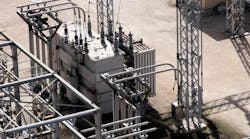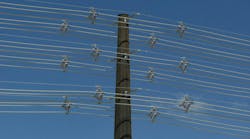As was the Case in 2005 When Hurricane Rita Made Her Presence Known, Sam Houston Electric Cooperative found itself directly in the path of Hurricane Ike. Like many cooperatives, Sam Houston mainly serves a rural service territory. Located in eastern Texas, tall pines are the predominant trees, leaving Sam Houston's power lines vulnerable to falling trees and crashing limbs. Add the need to bring back primary taps feeding remote customers, and a storm the magnitude of Ike will bring the entire distribution system down.
STANDING READY
Once it became clear Ike was headed to the Texas coast, Sam Houston dusted off its emergency operations plan and put it in motion. The plan wasn't actually that dusty, and the employees' skills were still sharp from restoration work performed in 2005 after Hurricane Rita.
For Ike, tensions became elevated when Polk County Judge Thompson issued a mandatory limited evacuation order on Friday morning, Sept. 12 for flood-prone low-lying areas, mobile homes, travel trailers and substandard housing.
To meet the expected need for line and tree-trimming crews, Sam Houston Electric Cooperative initially secured the services of approximately 1300 crew members to arrive after the worst of the storm passed. Food, lodging and fuel had been secured to supply staging areas located throughout the service territory.
As the storm passed through, it left nary a customer untouched, as the cooperative found all of its 66,000 meters without power. After the brunt of the storm passed, crews assessed the damage from the air and by ground. Workers started the long process of removing trees and clearing debris. Once the tree trimmers cleared a path, line crews began repairing damaged lines, replacing poles and changing out transformers.
MAINTAINING A TENT CITY
Large tents and support facilities were set up near the towns of Coldspring, Tarkington and Woodville, each capable of housing and feeding 500 individuals with additional accommodations made available in Livingston.
Sam Houston Electric Cooperative's Mike Beumel was responsible for the Coldspring staging area. He picked up the nickname “The Mayor of Tent City,” which he didn't care for much.
Beumel shared a little about the chaos of the early days as the site was being readied for incoming crews. “We knew exactly what we'd be doing, but we pitched a lot of ideas back and forth and made a lot of phone calls, and it all came together.”
Maintaining a tent city can be quite the balancing act. A trailer full of food arrived at four in the morning. And diesel to fill the trucks was running low. But each of the workers at the Coldspring tent city, from the gas pumpers to the cooks to the security personnel, demonstrated the heart of a servant. Steve Comstock, the “Assistant Mayor of Tent City,” stated, “They are not here for the money; they are here to make a difference in people's lives.”
Of course, most of the linemen and tree trimmers were unaware of the commotion behind the scenes of the tent city, only recognizing that they had good food to eat, a bed to sleep in and a hot shower. Each morning they would pick up their box lunch, grab a few bags of ice, pick up the wire and hardware they would need, and head out for another day.
ASSESSING THE DAMAGE
Sam Houston Electric Cooperative also found that the Entergy Texas transmission grid, which delivers electricity to the Sam Houston distribution system, had been severely damaged, as well. As the cooperative worked to clear trees and repair distribution lines, Entergy was doing the same on its transmission system.
Line workers and tree trimmers continued to pour in throughout the day on Monday, Sept. 15, and Tuesday, Sept. 16, so that by Tuesday afternoon, the total workforce exceeded 2500. Assessment teams found that Hurricane Ike had delivered twice the damage to Sam Houston's 10-county service territory that Hurricane Rita delivered in 2005.
RESTORING THE POWER
On Wednesday, Sept. 17, power was first returned to parts of Honey Island, Big Sandy, Huntington and Livingston. Because of extensive damage across east Texas, the state directed Sam Houston Electric Cooperative to focus early restoration efforts to restore power to priority loads including hospitals and nursing homes. As the morning progressed, more and more customers were receiving power. Four days after Hurricane Ike had made landfall, Sam Houston Electric Cooperative had restored power to 15,000 meters.
The call center began to provide county-by-county status reports as power was brought back on. The Sam Houston call center was staffed around the clock to take calls and provide customers with updates. The representatives answering the phones at Sam Houston remained unusually calm and collected, but their jobs were getting a little more difficult as some customers got their lights back and others didn't.
Sam Houston service representative Tina Montavo said, “As expectations rise, everyone wants to know, ‘When will I get my power?’”
A typical call to Tina proceeded like this:
“Good morning, this is Sam Houston Electric Cooperative. What is the name your service is under? As of today, they're working on the main feeder. They are still saying, in the more damaged areas, it could be several more weeks.”
Significant progress was being made, so that by Thursday, Sept. 18, 33% of the co-op's electrical distribution system had been restored. By noon on Friday, Sept. 19, 33,000 meters had power. One week after Hurricane Ike hit, power was restored to 75% of Sam Houston's electrical distribution system, and by Thursday, Sept. 25, power was restored to all members who were able to safely receive service (99.7%).
AUTOMATICS BY THE DOZENS
Duke line crews were working their way down a single-phase 7200-V #4 ACSR line running down Nicholson Road in Conroe, Texas. As the crews encountered down lines, they would repair broken conductor by installing automatic splices. Lineman Adam Canteu and foreman Mark Martin were able to maneuver their vehicles through the woods down a tap line to replace a pole and transformer that had been taken down by a massive pine tree.
Back north of Livingston, supervisor Jerry Badillo and his four T&D Solutions crews had come up from the Rio Grande Valley to work Ike for Sam Houston. A tap line that went across Highway 59 was down. Over time, five buckets gathered. The police were called in to stop traffic. A lineman located the first truck near the first pole and suspended a conductor reel near the pole, so the reel could be rotated while line was unspooled. Another bucket was placed on the right side of the divided highway. The next bucket was placed in the grass in the center of the divided highway. The next bucket was located on the other side of the highway. Another bucket was located between the road and the second pole.
Using their buckets like human arms, the linemen transferred the conductor from one lineman to another until the highway was crossed and the line tightened and secured. The crews again scattered and continued to work the main line and the laterals along Highway 59.

